英語セッション ワルドロン島での暮らし
|
|
2010年11月1日(月)
|

2010年10月31日、ヨハネ研究の森にアメリカからゲストが来校しました。
ゲストのロイド親子は、アメリカ合衆国ワシントン州のサンファン諸島で自給自足の生活を送っています。
大人と子どもが共に生活し、共に学びあうワルドロン島での暮らしについてお話してくれました。
アメリカからのゲストを迎えたヨハネ研究の森。
日本の教育や文化に興味があるという高校三年生のカミラ・ロイドさんとそのお母さんのジュリア・ロイドさんの二人は、
1週間ヨハネ研究の森に滞在しました。
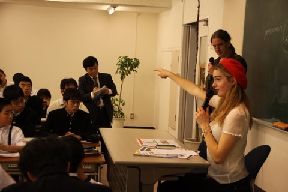 英語のゼミやセッションでは、ロイド親子のワルドロン島での生活について話を聞きました。
英語のゼミやセッションでは、ロイド親子のワルドロン島での生活について話を聞きました。
ワルドロン島には、お店がありません。自分たちで野菜を育て、電気もソーラー発電、移動手段は主に自転車。
全部で100名ほどの島の人たちはみんな知り合いで、みんな仲良く暮らしているといいます。
ロイドさんたちは、なぜお店もない、小さな島に移り住むという選択をしたのでしょうか。
それは、「子どもを育てるため」とジュリアさんは言いました。
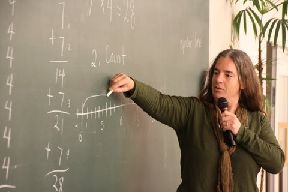 「子どもたちの後をついて歩いて、あれはしてはダメ、これをしてはダメと言うのは嫌だった。
だったら、そんな危険のないところで子どもを育てようと思ったの」と孟母三遷を地で行くロイド家の子育て。
「子どもたちの後をついて歩いて、あれはしてはダメ、これをしてはダメと言うのは嫌だった。
だったら、そんな危険のないところで子どもを育てようと思ったの」と孟母三遷を地で行くロイド家の子育て。
ロイド親子のワルドロン島での暮らしについてのプレゼンテーションは、
自分たちの生活を自分たちで作り上げている様子が生き生きと伝わってくるものでした。
ヨハネ生たちは、ロイド親子とのやり取りから何を感じ取ったでしょう。
英語だけでなく、生き方まで含めて刺激を与えてくれました。
ここでは、ロイド親子によるワルドロン島での暮らしについてのプレゼンテーションの様子をお伝えします。
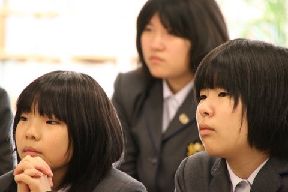
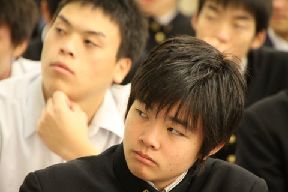
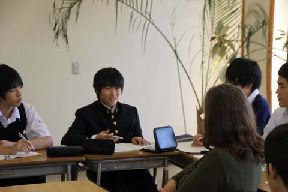
THE LIFE OF WALDRON
On November 1, Akabane Yayoi Sensei introduced a mother-daughter team
from America whom she had met on her travels there. Both Julia Loyd and her
daughter Camilla are artists and teachers.
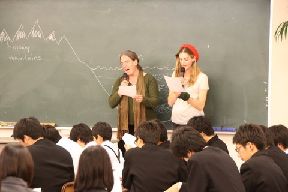 Camilla brought pictures showing their life on a small, isolated island in
the waters near Seattle. These pictures showed a life that is very different from
a typical urban Japanese life. How is the human experience on Waldron different
from life at Yohane School? How is it the same?
Camilla brought pictures showing their life on a small, isolated island in
the waters near Seattle. These pictures showed a life that is very different from
a typical urban Japanese life. How is the human experience on Waldron different
from life at Yohane School? How is it the same?
In 1920, the population of the entire USA shifted from rural to urban.
This population movement has continued, just as it has around the world. In the
1970's, however, some American urban residents wanted to go back to living in
the countryside, using what they had learned from city living. Life on Waldron
reflects this. In the 1920's, Waldron residents were Native Americans and white
farmers. By the 1970's, the island was almost depopulated, and that was when
a group of urbanites moved there. Today, Waldron's population has farmers,
retired professionals, and young educated, people who are interested in using
their hands to make a living.
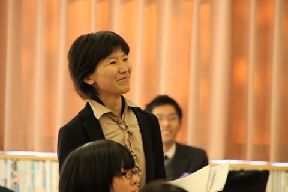 The island is small, both in size and population. There is an elementary/
middle school and a post office, but no grocery stores, inns, or other
businesses. Because there is no public water or electric system, households
have their own wells and solar panel arrays. Because there are no grocery
stores, people grow large gardens, and individuals sell or trade milk, eggs, and
meat.
The island is small, both in size and population. There is an elementary/
middle school and a post office, but no grocery stores, inns, or other
businesses. Because there is no public water or electric system, households
have their own wells and solar panel arrays. Because there are no grocery
stores, people grow large gardens, and individuals sell or trade milk, eggs, and
meat.
The center of Waldron island community is the school, where children
and adults learn together. Most classes are hands-on classes, which means
that the learners study by doing. During history class, for example, experts are
invited to teach subjects like weaving, cotton growing, carpentry, and other skills
that have been replaced by factories. In this way the learners are able to
experience for themselves a bit of ancient life.
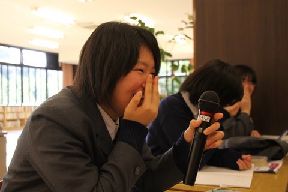 What are the economics of Waldron? Most residents are retired
professionals, so they don't have to worry about this question. But for the
younger adults, it is a big question. Most people solve it by creating many part-
time jobs. For example, Julie is an artist. She makes oil paintings to sell and has
private students in both art and writing. She also spins wool from her sheep and
sells the hats she knits. She works part-time as a teacher at the school, and
part-time as a data collector, data analyst, and website coordinator for the
science groups. Camilla's father, Julie's husband, runs the boat which takes
people from Waldron to ferry-served islands. He also writes poetry, and serves
on a government committee which coordinates activities that affect the marine
environment. Other people have a similar range of employment.
What are the economics of Waldron? Most residents are retired
professionals, so they don't have to worry about this question. But for the
younger adults, it is a big question. Most people solve it by creating many part-
time jobs. For example, Julie is an artist. She makes oil paintings to sell and has
private students in both art and writing. She also spins wool from her sheep and
sells the hats she knits. She works part-time as a teacher at the school, and
part-time as a data collector, data analyst, and website coordinator for the
science groups. Camilla's father, Julie's husband, runs the boat which takes
people from Waldron to ferry-served islands. He also writes poetry, and serves
on a government committee which coordinates activities that affect the marine
environment. Other people have a similar range of employment.
Many jobs, like farming, boat building, and fishing help to make the
island more self sufficient, able to survive on it's own. On Waldron Island people
try to live in harmony with nature and so try to grow their own food and ride
bicycles instead of driving cars. In this way people live as individuals in the
world, they do not need much food, money, or gasoline from others. But in
another way people live as a group. Everyone knows everyone else and most
people are friends. At the Loyd house Camilla and Julie receive at least two
visitors a day and visit at least one other person. People exchange books,
ideas, laughter, and teaching every day. In this way the people are not self
sufficient; they need other people to be happy.
In some ways, life is similar to life in a simpler past, but it is not the
same. Islanders are educated, (in other words, prepared for their life),they
have computers, solar panels, and amazon.com. They learn from the past but
do not live in the past.
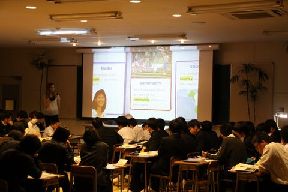 What do children do after they leave the middle school? There is no
high school on Waldron Island, but Julie has taught small groups of teenagers
the high school subjects for a few years. Camilla studies at home, and with
community members who are willing to teach her specific subjects. She studied
French with an Iranian woman who grew up in France, mathematics with a
retired statistician, and science with a professional botanist.
What do children do after they leave the middle school? There is no
high school on Waldron Island, but Julie has taught small groups of teenagers
the high school subjects for a few years. Camilla studies at home, and with
community members who are willing to teach her specific subjects. She studied
French with an Iranian woman who grew up in France, mathematics with a
retired statistician, and science with a professional botanist.
Each group of Yohane, as well as the teachers,heard a different piece of this story.
In the next weeks, this is a good opportunity to think about how a community is formed
and how groups of people can find ways to join together into a community. When cities
were smaller and fewer, more people lived in small communities like Waldron. By talking
with Julie and Camilla students can learn hands-on and see one way that learning about
history can show you better ways to live in the future.

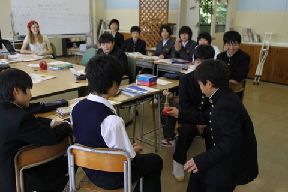

|
|
|